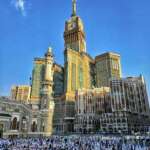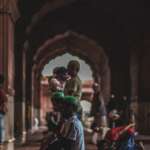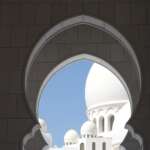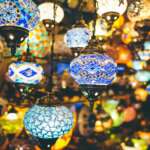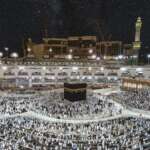When did the Eid al-Adha start?
About Eid al-Adha Holiday
Eid al-Adha is an important religious holiday in the Islamic faith celebrated by Muslims around the world. It is celebrated to commemorate and honor the Prophet Abraham’s readiness to sacrifice his son Ismail as an act of obedience to Allah. As a sign of obedience, Allah saved Ismail and sacrificed a ram instead.
Eid al-Adha is celebrated with Muslim families coming together to perform special prayers, as well as distribute gifts amongst family members. Many families will also gather to feast on traditional treats such as sweet dishes, lamb or goat meat, and other savory delicacies. Additionally, it is common for families to use extra money to provide food and other items to the poor and needy people in their community. Overall, Eid al-Adha is a joyous time for family and friends to get together and share their love and appreciation for one another.
Introduction
Eid al-Adha, also known as the Festival of Sacrifice, is one of the most important holidays in the Islamic calendar. It is celebrated by millions of Muslims around the world, marking the end of the annual pilgrimage to Mecca known as Hajj. This holiday also commemorates the willingness of Prophet Ibrahim (Abraham in Christianity and Judaism) to sacrifice his son as an act of obedience to God. In this article, we will dive deeper into the origins, significance, traditions, and celebrations of Eid al-Adha.
Key Takeaways
- Eid al-Adha is a major holiday for Muslims, marking the end of the annual Hajj pilgrimage.
- It commemorates the story of Prophet Ibrahim’s willingness to sacrifice his son as an act of obedience to God.
- This holiday is known for its rich cultural significance, traditional elements, and delicious food.
- It is celebrated in many countries around the world, with variations in traditions and customs.
History and Origin
Eid al-Adha has its roots in the story of Prophet Ibrahim’s test of faith, as mentioned in the Quran and the Old Testament. According to Islamic belief, God commanded Prophet Ibrahim in a dream to sacrifice his son, Ismail. To prove his unwavering devotion to God, Prophet Ibrahim was willing to carry out the sacrifice. However, at the last moment, God provided a ram to be sacrificed instead, as a symbol of His mercy and forgiveness.
This story holds great significance in the Islamic faith, as it teaches the importance of submission, faith, and trust in God. It is also a reminder of God’s mercy and blessings upon His believers. The actual event of Prophet Ibrahim’s near sacrifice of his son happened in Mina, a valley near Mecca, and this location remains a significant pilgrimage site for Muslims during Hajj.
Historical Context
Eid al-Adha has been celebrated by Muslims for centuries, with its roots tracing back to the time of Prophet Ibrahim. Over the years, the holiday has evolved and incorporated local customs and traditions, depending on the region. This holiday also holds historical significance, as it reflects the unification of the Muslim community and the importance of sacrifice for the sake of God.
In the early days of Islam, Eid al-Adha was celebrated with a large communal sacrifice, which was then distributed to the poor and needy. Today, this tradition continues in many parts of the world, where people donate money or food to those in need. The holiday also brings families and communities together, promoting unity and generosity.
Significance and Meaning
For Muslims, Eid al-Adha is a joyous occasion to celebrate and remember Prophet Ibrahim’s ultimate test of faith. It is a time for reflection and gratitude for God’s mercy, blessings, and guidance. Families and friends gather to spend time together, share meals, and exchange gifts. It is also a time to give back to the community, by helping the less fortunate and participating in charitable activities.
Cultural Significance
Eid al-Adha is deeply ingrained in Islamic culture, with many traditional elements and rituals associated with the holiday. These cultural symbols hold deep meanings and represent the essence of the holiday. For example, the Kaaba, the black cube-shaped building in Mecca, is considered the holiest site in Islam and holds religious significance for Muslims. During Hajj and Eid al-Adha, pilgrims perform the Tawaf, a ritual of circling the Kaaba seven times, as a sign of devotion to God.
Symbols and Decorations
The primary symbol associated with Eid al-Adha is the sacrificial animal, usually a sheep, goat, cow, or camel. This animal represents Prophet Ibrahim’s son, Ismail, and the willingness to sacrifice for the sake of God. Other decorations include colorful lights, banners, and traditional Islamic artwork, which add to the festive atmosphere.
Traditions and Celebrations
Eid al-Adha is a time for celebration and togetherness, with Muslims across the world participating in various traditions and customs. The day begins with the Eid prayer, a special congregational prayer held in mosques or open spaces, followed by a sermon. After the prayer, families and friends exchange greetings, saying “Eid Mubarak,” which means “Blessed Eid.”
Traditional food and sweets play a significant role in Eid al-Adha celebrations. Families gather to prepare and share delicious meals, with some dishes having cultural and religious significance. For example, in the Middle East, lamb is the most commonly cooked meat, symbolizing the animal sacrificed by Prophet Ibrahim. In other parts of the world, different dishes like biryani, kabsa, or kebabs are enjoyed.
Food and Cuisine
Food is an important aspect of Eid al-Adha celebrations, with different regions having their unique dishes. One dish that is commonly prepared during this holiday is Qurbani Kebabs, made with the sacrificial meat, onions, spices, and herbs. Another popular dish is Haleem, a slow-cooked stew made with wheat, lentils, and meat. Sweets and desserts, such as baklava, gulab jamun, and kheer, are also served to mark the end of the feast.
Attire and Costumes
On Eid al-Adha, Muslims around the world dress in their best attire to attend the Eid prayers and spend time with family and friends. Men often wear traditional garments, like a thobe or kurta, while women opt for colorful and elegant dresses, like a shalwar kameez or abaya. Children are also dressed in their best clothes and are often given Eid gifts or money as a part of the celebration.
Music and Songs
Music and songs are an integral part of Eid al-Adha celebrations, with traditional tunes played in homes and public gatherings. These songs often praise God, commemorate the story of Prophet Ibrahim, and celebrate unity among believers. Children also participate by singing catchy Eid songs, adding to the joyful atmosphere of the holiday.
Geographical Spread
Eid al-Adha is celebrated in many countries around the world, with a significant Muslim population. While the holiday is observed in countries like Saudi Arabia, Turkey, and Kuwait, it is also celebrated in countries with small Muslim communities, like India, the United Kingdom, and the United States. Each country has its unique way of celebrating this holiday, with regional variations in traditions and customs.
Modern-Day Observations
Over the years, Eid al-Adha has evolved, incorporating modern elements and adapting to changing times. For instance, instead of sacrificing animals individually, some countries have introduced the concept of communal sacrifices, where a group of people can share the cost and participate in the ritual together. With technological advancements, it is also common to send Eid greetings and wishes through social media and digital platforms.
Interesting Facts or Trivia
- The exact date of Eid al-Adha varies, as it follows the Islamic lunar calendar.
- Eid al-Adha is the second most significant holiday in Islam, after Eid al-Fitr.
- In some countries, the festival is known as Eid-ul-Zuha or Bakra Eid.
- The meat from the sacrificial animal is divided into three parts – one for the family, one for relatives and friends, and one for the poor and needy.
Legends and Myths
There are many legends and myths associated with Eid al-Adha, passed down through generations. One such story talks about Prophet Muhammad’s grandson, Imam Hussain, who was martyred on the 10th day of the Islamic month of Muharram, which coincides with Eid al-Adha. As a sign of respect and remembrance, some Muslims perform a ritualistic sacrifice on this day as well.
Social and Economic Impact
Eid al-Adha has a significant impact on the social and economic aspects of the communities that celebrate it. It brings families and communities closer, promoting unity and generosity. The holiday is also a time when businesses thrive, as people buy new clothes, gifts, and food items. In some countries, tourism also increases during this time, as Muslims from around the world travel to celebrate this holiday.
Economic Impact
Eid al-Adha has a significant economic impact on local businesses, especially those involved in the production and sale of meat, clothing, and decorations. It also boosts tourism in countries that attract pilgrims during Hajj and Eid al-Adha. The holiday also has a positive impact on small businesses and vendors, as people buy gifts and sweets to celebrate with their loved ones.
Environmental Aspect
In recent years, there has been a growing concern about the environmental impact of the holiday, specifically in terms of animal sacrifice and waste management. As a way to minimize the environmental impact, some communities have introduced regulations and guidelines for the safe and ethical sacrifice of animals. They also promote responsible disposal of waste and encourage donation of meat to those in need.
Tourist Guide
If you are planning to visit a country where Eid al-Adha is celebrated, here are some practical tips for tourists:
- The date of Eid al-Adha changes every year, so plan your visit accordingly.
- Major cities and towns often host special Eid celebrations, with street fairs, parades, and cultural events.
- If you wish to attend Eid prayers at a mosque, make sure to dress appropriately and arrive early.
- Be respectful of local customs and traditions by learning about them and participating with an open mind.
- If you are invited to an Eid feast, try the traditional dishes and share in the festive spirit.
Local Perspective
To gain a deeper understanding of Eid al-Adha and its cultural importance, we spoke to a local Muslim from Saudi Arabia, Khalid Al-Muhairy. “Eid al-Adha is a time for reflection on our faith and the sacrifices made by our ancestors. It is also a time to share joy and blessings with our loved ones and to give back to the community. The celebration of this holiday brings us closer and strengthens our sense of belonging as Muslims,” shared Khalid.
Global Relevance
While Eid al-Adha is primarily a holiday celebrated by Muslims, it holds relevance for people of different faiths and cultures. The story of Prophet Ibrahim’s test of faith and God’s mercy resonates with many, and the holiday serves as an opportunity to learn about and appreciate Islamic traditions. It also promotes cultural understanding and harmony among diverse communities.
Other Popular Holiday Info
- Eid al-Adha is a time of forgiveness, and many Muslims use this holiday to reconcile with friends and family members.
- In some countries, fireworks are part of Eid al-Adha celebrations, adding to the festive atmosphere.
- Eid al-Adha is a public holiday in many Muslim-majority countries, with schools, offices, and businesses closed for the day.
Conclusion
Eid al-Adha is a holiday that holds deep cultural significance and religious importance for Muslims around the world. It is a time to reflect on faith, family, and community, and to celebrate the values of submission, unity, and sacrifice. The holiday brings people together, promotes generosity and goodwill, and has a positive impact on the economy and the environment. Whether you are a Muslim or not, Eid al-Adha is a holiday worth experiencing and learning about, to gain a deeper understanding of Islamic culture and traditions.
How to Say "Eid al-Adha" In Different Languages?
- Arabic
- عيد الأضحى (ar-EG)
- Bulgarian
- Ид ал-Адха (bg-BG)
- Croatian
- Bajram (hr-HR)
- Czech
- Eid al-Adha (cs-CZ)
- English
- Eid al-Adha (en-GB)
- English
- Eid al-Adha (en-CA)
- Finnish
- Kurban Bayrami (fi-FI)
- French
- L'Aïd el-Kébir (fr-BE)
- French
- L'Aïd el-Kébir (fr-FR)
- German
- Eid al-Adha (de-DE)
- German
- Eid al-Adha (de-AT)
- Greek
- Είδος της Άδης (el-GR)
- Hindi
- ईद-अल-अदहा (hi-IN)
- Indonesian
- Idul Adha (id-ID)
- Italian
- Eid al-Adha (it-IT)
- Malay
- Hari Raya Qurban (ms-SG)
- Persian
- عید الأضحى (fa-IR)
- Portuguese
- Eid al-Adha (pt-BR)
- Russian
- Великий праздник Аэры (ru-RU)
- Spanish
- Eid al-Adha (es-AR)
- Spanish
- Eid al-Adha (es-MX)
- Swedish
- Eid al-Adha (sv-SE)
- Turkish
- Kurban Bayramı (tr-TR)
- Vietnamese
- Eid al-Adha (vi-VN)
Eid al-Adha Also Called
The Feast of Sacrifice or the Festival of the Sacrifice.Countries where "Eid al-Adha" is celebrated:
- :: Africa
- :: Algeria
- :: Chad
- :: Egypt
- :: Libya
- :: Mali
- :: Morocco
- :: Nigeria
- :: Senegal
- :: Sierra Leone
- :: Somalia
- :: Sudan
- :: Tunisia
- :: Western Sahara
- :: Asia
- :: Afghanistan
- :: Azerbaijan
- :: Bangladesh
- :: Brunei Darussalam
- :: Indonesia
- :: Kazakhstan
- :: Kyrgyzstan
- :: Malaysia
- :: Maldives
- :: Pakistan
- :: Tajikistan
- :: Turkmenistan
- :: Uzbekistan
- :: Europe
- :: Albania
- :: Bosnia and Herzegovina
- :: Turkey
- :: Middle East
- :: Bahrain
- :: Iran
- :: Iraq
- :: Jordan
- :: Kuwait
- :: Lebanon
- :: Oman
- :: Qatar
- :: Saudi Arabia
- :: Syria
- :: United Arab Emirates
- :: Yemen
FUN FACT:
In year 624 CE, Eid al-Adha is celebrated on July 7 for the first time.HOLIDAY CHECK: We strive for accuracy and fairness. But if you see something that doesn't look right, please click here to contact us!
Travel Recipes, Food and Cuisine
Food and Cuisine - Eid al-Adha
The holiday of Eid al-Adha, also known as the "Festival of Sacrifice," is one of the most significant celebrations in the Islamic calendar. This joyous occasion is marked by the sharing of delicious food and drinks with family and friends, symbolizing the spirit of community and gratitude. Let's explore the rich flavors, history, and recipes that make Eid al-Adha's cuisine a feast for the senses.Signature Dishes
One of the most iconic dishes associated with Eid al-Adha is the traditional main course, lamb or goat meat cooked in various ways. The most famous preparation is the slow-roasted whole lamb or goat, known as "Biryani." This dish is deeply rooted in Islamic culture and symbolizes the sacrifice and generosity of Prophet Abraham, which is the basis of the holiday. Another popular dish is "Harira," a hearty soup made with lamb, chickpeas, lentils, and a blend of aromatic spices. No Eid al-Adha celebration is complete without "Sheer Khurma," a sweet vermicelli pudding flavored with cardamom, saffron, and dried fruits, which is served as a traditional dessert.Regional Variations
Although the core dishes remain the same, the preparations and flavors of Eid al-Adha cuisine vary across different regions of the world. For example, in the Middle East, "Maqluba," a layered rice dish with meat and vegetables, is a popular choice. In South Asian countries, "Korma," a creamy meat curry with rich spices and nuts, is a staple dish for celebrations. In African countries like Egypt, "Mutabbaq," a savory meat-filled pastry, is a common Eid al-Adha specialty.Recipes
Let's dive into some classic and modern twist recipes that will be a hit at your Eid al-Adha feast.Classic Holiday Recipes
- Biryani:
- Ingredients:
- 1 whole lamb or goat, cleaned and trimmed
- 5 cups basmati rice
- 2 large onions, sliced thinly
- 5 cloves of garlic, minced
- 1 ginger, grated
- 1 teaspoon cumin powder
- 1 teaspoon coriander powder
- 1 teaspoon turmeric powder
- 1 teaspoon garam masala powder
- Salt to taste
- 1 cup clarified butter or ghee
- Instructions:
- Marinate the lamb or goat with garlic, ginger, turmeric, cumin, coriander, garam masala, and salt for at least 4 hours or overnight.
- In a large pot, sauté the thinly sliced onions in ghee until caramelized.
- Add the marinated lamb or goat and cook until browned on all sides.
- Add water and let the meat simmer until cooked and tender.
- In a separate pot, boil the rice with water and salt until half cooked.
- Layer the cooked rice and meat in a large pot, ending with a layer of rice on top.
- Cover the pot and let it cook on low heat for 30 minutes.
- Fluff the rice and meat with a fork and serve hot with garnishes of your choice.
- Harira:
- Ingredients:
- 1 lb boneless lamb or goat, cut into cubes
- 1 onion, finely chopped
- 1 can chickpeas, drained and rinsed
- 1 cup lentils, rinsed
- 1 cup diced tomatoes
- 1 teaspoon cumin
- 1 teaspoon coriander
- 1 teaspoon turmeric
- 1 teaspoon paprika
- Salt to taste
- 4 cups of water or lamb stock
- Cilantro, chopped for garnish
- Instructions:
- In a large pot, sauté the chopped onion until golden brown.
- Add the diced tomatoes and spices and cook for 2-3 minutes.
- Add the cubed lamb or goat and cook until browned on all sides.
- Add the lentils and water or lamb stock, and let it simmer for 30 minutes or until the lentils are cooked.
- Add the drained chickpeas and let it cook for another 10 minutes.
- Adjust seasoning according to taste.
- Garnish with chopped cilantro and serve hot.
Modern Twists on Traditional Flavors
The best way to add a modern twist to traditional dishes is by experimenting with different ingredients while staying true to the essence of the dish. For example, adding a dash of pomegranate molasses to the Biryani marinade or substituting plain water with coconut milk in the Harira soup can elevate the flavors and give a unique touch to the dishes.Preparation and Cooking Tips
To ensure authentic and tasty results, here are some practical tips for preparing and cooking Eid al-Adha dishes:- Clean and trim the meat beforehand to remove any unwanted smells or debris.
- Marinate the meat for at least 4 hours or overnight to infuse the flavors.
- Add a pinch of saffron to the Biryani or Harira for an extra burst of flavor and vibrant color.
- Use a slow cooker to achieve tender and succulent meat.
- For a healthier option, use lean cuts of meat and reduce the amount of oil and salt in the recipes.
Pairings and Presentations
Complementary Pairings
To balance out the richness of the main courses, here are some drink and side dish pairings that go well with the featured recipes:- Mint and yogurt-based drinks like "Lassi" or "Ayran" to cool down the spiciness.
- Fluffy naan or pita bread to soak up the flavorful Biryani gravy.
- Fresh salads with a citrus dressing to refresh the palate.
- Roasted vegetables like eggplant or squash to add a healthy touch to the meal.
Decorative and Festive Presentation
To create a festive ambience, here are some ideas for presenting the Eid al-Adha dishes:- Serve the Biryani in a large platter and top it with shredded carrots, fried onions, and nuts for an eye-catching display.
- For Harira, serve it in individual bowls and garnish with a swirl of yogurt or a sprinkle of fresh herbs.
- For Sheer Khurma, present it in a decorative glass bowl and top with edible rose petals or pistachios for a pop of color.
Nutritional and Dietary Considerations
Although Eid al-Adha dishes are known for their rich and indulgent flavors, here are some tips for making them healthier or suitable for dietary restrictions:Healthier Options
- Instead of traditional ghee, use olive oil or avocado oil for cooking.
- Swap white rice with brown rice or quinoa for added fiber and nutrients.
- Use lean cuts of meat like lamb loin or skinless chicken breast.
- Reduce the amount of salt and sugar used in the recipes.
Ingredient Substitutions
- For gluten-free options, use rice or corn-based products instead of wheat-based ones.
- Replace lamb or goat with beef or chicken for a lighter protein option.
- Use vegetable broth or coconut milk instead of meat broth for vegetarian or vegan guests.
- For lactose-intolerant individuals, use dairy-free alternatives like almond milk or coconut cream in recipes.
Conclusion
Eid al-Adha is a time of joy, gratitude, and delicious food. With these classic and modern twist recipes, preparation and cooking tips, and pairing and presentation ideas, you can create a memorable feast for your loved ones. Remember to adapt the recipes according to your personal taste and dietary needs and experiment to add your unique touch to the dishes.FAQs
- What is the significance of Biryani in Eid al-Adha celebrations?
- The long, slow cooking process and the use of aromatic spices in Biryani symbolize the patience and sacrifice of Prophet Abraham, making it a staple dish for Eid al-Adha.
- Can I use chicken instead of lamb in these recipes?
- Yes, you can substitute the meat with chicken for a lighter option, but the cooking time may vary.
- Are there any dairy-free alternatives for the Sheer Khurma recipe?
- You can use almond milk or coconut cream in place of regular milk for a dairy-free version of Sheer Khurma.
Additional Resources
Songs and Music
The Definitive Holiday Music Guide
The Eid al-Adha, also known as the "Festival of Sacrifice," is a significant holiday in the Islamic calendar. It commemorates the willingness of Ibrahim (Abraham) to sacrifice his son as an act of obedience to God. The occasion is celebrated with fervor in many parts of the world, and music is an integral part of the festivities. The melodious tunes add to the joy and jubilation of the holiday, creating a vibrant, celebratory atmosphere. As we delve into the musical tapestry that adorns the Eid al-Adha, we discover a rich collection of timeless melodies, iconic anthems, and modern hits that capture the essence of the holiday's spirit.Timeless Holiday Melodies
The Eid al-Adha has a deep-rooted history, and its music reflects this tradition and heritage. One of the most beloved songs is "Eid-e-Qurban" by the legendary Pakistani musician, Nusrat Fateh Ali Khan. The qawwali-style rendition, with its soulful verses and stirring vocals, is a staple in many households during the holiday. Another popular song is "Aaj Khushiyan Manayen" by renowned Indian playback singer, Lata Mangeshkar. The joyous melody, with its upbeat rhythm and festive lyrics, encapsulates the spirit of the occasion. For a more nostalgic touch, the classical composition "Hai Eid Aaj" by Indian vocalist Mohammad Rafi is a must-listen. The poetic lyrics, accompanied by the melodic sitar, transport listeners to a bygone era of celebration and community. Other timeless holiday melodies include "Al-Lailatul-Qadri" by the Moroccan singer Sabah Fakhri and "Zikr" by the Lebanese singer, Fairuz.Accompany descriptions of classic songs with embedded YouTube videos for an enhanced audio-visual experience.
- "Eid-e-Qurban" by Nusrat Fateh Ali Khan: https://www.youtube.com/watch?v=XV03xbFxL5g
- "Aaj Khushiyan Manayen" by Lata Mangeshkar: https://www.youtube.com/watch?v=XwrsUceHmRY
- "Hai Eid Aaj" by Mohammad Rafi: https://www.youtube.com/watch?v=rU5j8RrsOLA
- "Al-Lailatul-Qadri" by Sabah Fakhri: https://www.youtube.com/watch?v=7XonI1jJw6E
- "Zikr" by Fairuz: https://www.youtube.com/watch?v=eJuM4OaWjRQ
Essential Holiday Music Collection
The Eid al-Adha has a plethora of iconic anthems that have become synonymous with the holiday. Here are some must-have tracks for your holiday playlist.Iconic Holiday Anthems
| Artist | Song |
|---|---|
| Salim-Sulaiman | Ali Maula |
| Rahat Fateh Ali Khan | I Am A Momin |
| Atif Aslam | Tajdar-e-Haram |
| Natasha Baig & Shani Arshad | Muslim Rangers - Pak Sar Zameen |
| Sahir Ali Bagga & Aima Baig | Chaap Tilak |
Modern Holiday Classics
The evolution of holiday music can be seen with the rise of modern hits that have become instant favorites. Here are some contemporary songs that have made a mark on the Eid al-Adha:| Artist | Song | Year Released |
|---|---|---|
| Coke Studio | Bol Hu | 2019 |
| Sidhu Moose Wala | Violence | 2019 |
| Abida Parveen & Ali Sethi | Tera Naam | 2017 |
| Junoon | Khudi | 1996 |
| Jawad Ahmed & Sajjad Ali | Chandni Raatein | 2001 |
Modern Holiday Hits
Adding to the modern holiday classics are these recent hits that have captured the hearts of listeners across the globe:- "Noor-e-Azal" by Atif Aslam, Abida Parveen, and Ali Sethi: https://www.youtube.com/watch?v=ESnTeoRLl2k
- "Bhar Do Jholi Meri" by Adnan Sami: https://www.youtube.com/watch?v=NtILxBszyf8
- "Mera Zikr" by Darshan Raval: https://www.youtube.com/watch?v=V8kLVHHDkjg
- "Allahu Akbar" by Salim-Sulaiman: https://www.youtube.com/watch?v=QD-phoneoUWJg
- "Tu Hai Kamaal" by Amit Mishra and Rashid Khan: https://www.youtube.com/watch?v=eHzGuTkrKJA
Holiday Playlists for Every Mood
From contemplative tunes to upbeat tracks, the Eid al-Adha music offers a variety of choices for every mood. Here are some curated playlists to suit your emotional state during the holiday:Soundtracks That Defined Generations
This playlist is dedicated to the golden age of holiday music, capturing the nostalgia and sentimentality of past celebrations. The tracks evoke a sense of togetherness and community, depicting how the holiday transcends generations.- "Assalamualikum" by Michael Jackson
- "Jholi Bhar De" by Rahat Fateh Ali Khan
- "Noor-e-Azal" by Atif Aslam, Abida Parveen, and Ali Sethi
- "Eid Special" by Various Artists
- "Yasmin" by Mekanikyl Man
Songs of Celebration: For Kids and Adults
The holiday is a time for family, and this playlist caters to the young and old alike. Incorporating catchy, fun-filled tunes and traditional songs, this list is sure to get everyone in the celebratory mood.- "Eid Mubarak" by Eeman Kids
- "Bohemia Eid Rap" by Fizzyluds
- "Eid Ka Chaand" by Sathyam Matadin
Films: Movies, Cartoons and Documentaries
Holidays Movies and Entertainment for Eid al-Adha
Eid al-Adha is an important holiday in the Islamic faith, commemorating the story of Prophet Ibrahim's willingness to sacrifice his son in obedience to God. As the holiday approaches, many families gather to celebrate with traditions, delicious food, and entertaining activities. In addition to these customs, many turn to films, cartoons, and documentaries that capture the essence of Eid al-Adha. From classic titles to family-friendly cartoons and educational documentaries, there is something for everyone to enjoy during this festive time of the year.Eid al-Adha Movies
| Title | Khuda Gawah |
|---|---|
| Release Year | 1993 |
| Genre | Action, Adventure, Drama |
| Movie Description | Khuda Gawah is a Bollywood epic drama that revolves around the love story of a Muslim horse-trainer and an Afghan princess. The film showcases the significance of faith, family, and sacrifice, making it a perfect choice for Eid al-Adha. |
| Cast and Crew | Directed and written by Mukul Anand, Khuda Gawah boasts a star-studded cast including Amitabh Bachchan, Sridevi, Danny Denzongpa, and Nagarjuna. |
| Trivia and Fun Facts | Khuda Gawah was initially titled "Ragaa" which means passion in Persian. The film's iconic song "Tu Mujhe Qabool" was shot at the world-famous Taj Mahal, making it the first Bollywood film to feature the monument. |
| Production Details | Khuda Gawah was shot in four different countries, including India, Afghanistan, Switzerland, and Nepal. It took over two years to complete the film's production. |
| Awards and Nominations | The film won multiple awards at the 39th Filmfare Awards, including Best Actor, Best Supporting Actor, and Best Sound Design. It was also nominated for Best Film and Best Director. |
Other must-watch movies for Eid al-Adha include "The Message" (1976), an epic historical drama showcasing the origins of Islam and the story of Prophet Muhammad, and "Bab'Aziz: The Prince Who Contemplated His Soul" (2005), a beautifully crafted Egyptian film that explores the themes of faith, love, and destiny.
Family-Friendly Eid al-Adha Cartoons
While adults may enjoy watching dramas and historical epics, it is important to include entertainment that caters to younger audiences during Eid al-Adha celebrations. Cartoons and animated features are a perfect choice for families looking to spend quality time together. Some popular Eid al-Adha themed cartoons include:- Muhammad: The Last Prophet - This 2002 animated film portrays the story of Prophet Muhammad's life and teachings, in a way that is educational and engaging for children.
- Zaky's Adventures: "The Story of Ibrahim" - This short animated feature is part of a series that teaches moral lessons and Islamic values to young viewers through lovable cartoon characters.
- Little Einsteins: "The Good Knight and the Bad Knight" - In this episode of the popular Disney animated series, the Little Einsteins embark on a musical adventure inspired by the story of Prophet Ibrahim.
Other recommended cartoons related to Eid al-Adha include "The Prince of Egypt" (1998), an animated musical retelling of the story of Moses and the Ten Commandments, and "Mirai" (2018), a heartwarming anime film that touches on the themes of faith, family, and self-discovery.
Exploring Eid al-Adha Traditions
For those looking to learn more about the cultural and historical significance of Eid al-Adha, several documentaries and educational content are available for viewing. These provide a deeper understanding of the holiday and its traditions.- "Eid al-Adha: The Story of Sacrifice" - This documentary by Al Jazeera English explores the history of Eid al-Adha, its rituals, and significance in various Muslim communities around the world.
- "Eid: The Greatest Western Muslim Festival" - This BBC documentary delves into the customs and traditions of Eid al-Adha and how it is celebrated in different parts of the world, from the United States to Turkey and beyond.
- "Visions of Paradise: The Hajj" - This National Geographic documentary follows several pilgrims on their journey to Mecca during the Hajj, including the celebration of Eid al-Adha, in a visually stunning and educational exploration of the Islamic holy site.
Beyond these documentaries, there are also many educational resources available online that provide insight into the significance of Eid al-Adha for Muslims and the wider community.
Eid al-Adha in Other Genres
Although not explicitly centered around Eid al-Adha, some films and shows manage to incorporate its themes and values in unexpected genres, adding an extra layer of depth and meaning.- "The Martian" - This sci-fi thriller stars Matt Damon as an astronaut stranded on Mars, who relies on his faith and resilience to survive. The story's themes of perseverance and overcoming challenges align with the spirit of Eid al-Adha.
- "The Mummy" - This fantasy adventure movie set in ancient Egypt features the character of Anck-Su-Namun, a priestess willing to sacrifice herself for the sake of her people, echoing the story of Prophet Ibrahim's sacrifice in Islamic traditions.
- "The Lion King" - This beloved animated classic is filled with themes of family, love, and sacrifice resonant with the spirit of Eid al-Adha. The story of Simba's journey towards fulfilling his destiny holds parallels to Prophet Ibrahim's story.
These titles provide an interesting and unique perspective on Eid al-Adha that goes beyond traditional representations in entertainment media.
Classic Eid al-Adha Specials
No celebration of Eid al-Adha would be complete without some of the timeless and iconic specials that have become a staple of holiday traditions. These specials continue to be enjoyed by people of all ages, year after year.- "Barney & Friends: "A Welcome Home" and "Gift of the Dinos" - These Eid al-Adha themed episodes of the popular children's show feature the beloved purple dinosaur and his friends learning about the significance of the holiday and its customs.
- "Omar & Hana:"Eid al-Adha" - This animated special from the Malaysian series "Omar & Hana" is a fun and educational introduction to Eid al-Adha for young viewers.
- "Seinfeld: "The Mom & Pop Store" - This classic episode of the beloved sitcom sees Jerry and his friends celebrate Eid al-Adha with their friend Babu Bhatt. The episode showcases the cultural exchange and misunderstandings that occur during the holiday.
These classics have become an integral part of the holiday experience for many families, adding laughter and warmth to the celebrations.
Music and Performances
In addition to films and cartoons, music and performances also play a significant role in celebrating Eid al-Adha. These showcase the diversity and richness of Islamic culture and traditions.- Maher Zain: "The Power" Concert - This live performance by the popular Muslim artist features uplifting, inspirational songs that celebrate the themes of faith, unity, and sacrifice, fitting for the holiday of Eid al-Adha.
- Dawud Wharnsby: "Road to Madinah" - This musical documentary showcases the journey of singer-songwriter Dawud Wharnsby as he travels to Medina during the Hajj, providing a unique perspective on the Islamic holy site and the celebration of Eid al-Adha.
- Noor Kids: "Proud To Be" - This catchy and educational song by the popular Muslim children's entertainment brand teaches young listeners about the significance of Eid al-Adha while spreading messages of love, unity, and community.
Musical performances like these add an extra layer of joy and celebration to the holiday, bringing people together through the power of music and art.
Conclusion
Eid al-Adha is a time of joy and celebration, filled with traditions and activities that bring families and communities together. In addition to these customs, exploring the diverse range of entertainment options available for Eid al-Adha can be a fun and engaging way to celebrate the holiday. From classics to educational content, these movies, cartoons, and documentaries showcase the values and significance of Eid al-Adha in a unique and captivating way.FAQ
- What genres are popular for Eid al-Adha movies? Popular genres for Eid al-Adha movies include drama, action, adventure, and romance.
- Do you have any recommendations for family-friendly cartoons for Eid al-Adha? Yes, some family-friendly cartoons suitable for Eid al-Adha include "Muhammad: The Last Prophet", "Zaky's Adventures: "The Story of Ibrahim"", and "Little Einsteins: "The Good Knight and the Bad Knight".
- Are there any documentaries exploring the history of Eid al-Adha? Yes, there are several documentaries available, such as "Eid al-Adha: The Story of Sacrifice" by Al Jazeera English and "Eid: The Greatest Western Muslim Festival" by BBC.
- Are there any genres that incorporate elements of Eid al-Adha in unexpected ways? Yes, genres like sci-fi, fantasy, and adventure often feature themes of faith, family, and sacrifice, aligning with the spirit of Eid al-Adha.
- Which classic specials are often associated with Eid al-Adha? Some iconic Eid al-Adha specials include "Barney & Friends: "A Welcome Home" and "Gift of the Dinos"", "Omar & Hana: "Eid al-Adha"", and "Seinfeld: "The Mom & Pop Store".
- Are there any musical performances related to Eid al-Adha? Yes, artists like Maher Zain, Dawud Wharnsby, and Noor Kids have created music and performances centered around the themes of faith, unity, and community, perfect for celebrating Eid al-Adha.
By embracing the diverse and engaging entertainment options available, we can make this Eid al-Adha an even more memorable experience. Happy Eid al-Adha!
Travel Guide, Tourism and Traveling
Tourism During Eid al-Adha: A Must-Read Guide for Travelers
Eid al-Adha, also known as the Festival of Sacrifice, is one of the most important celebrations in the Islamic calendar. This holiday, which commemorates the willingness of Abraham to sacrifice his son, is marked by much joy and festivity. For travelers, this is an ideal time to visit countries with large Muslim populations and experience the cultural traditions and religious practices associated with this holiday. In this comprehensive tourist guide, we will provide valuable information on tourism during Eid al-Adha, including tips for foreign visitors, festive activities, infrastructure and transport, accommodation options, local cuisine, shopping, technology, entertainment, eco-tourism, wellness, local festivals and events, and practical advice for an unforgettable trip.Introduction
As the streets and homes are decked out in colorful decorations and families come together to celebrate, the festive spirit of Eid al-Adha is hard to ignore. From the lively markets and bustling streets to the delicious food and traditional customs, tourism during Eid al-Adha offers a unique and immersive experience. This holiday also presents an opportunity to explore popular tourist attractions that take on a special significance during this time, creating unforgettable memories for travelers.Tourist Attractions
From the beautiful mosques and palaces to the vibrant bazaars and historic sites, there is no shortage of tourist attractions during Eid al-Adha. In countries with a significant Muslim population, the central mosque is usually adorned with colorful decorations and throngs of worshippers gather for special prayers. Markets and bazaars are also popular tourist destinations during this time, as people shop for new clothes and gifts for loved ones. Historical sites such as the Alhambra in Spain and the Blue Mosque in Turkey also attract a large number of tourists during Eid al-Adha.Important Places
If you're planning to travel during Eid al-Adha, here are some must-visit places: - Mecca, Saudi Arabia: As the birthplace of Islam, Mecca is the holiest city for Muslims and is the destination for millions of pilgrims during Eid al-Adha. - Istanbul, Turkey: This historic city comes alive with festive celebrations during Eid al-Adha, and the beautiful Blue Mosque is a must-visit. - Marrakech, Morocco: Known for its vibrant markets and culture, Marrakech is a popular spot for tourists during Eid al-Adha. - Kuala Lumpur, Malaysia: With its diverse cultural influences, this city offers a unique experience during Eid al-Adha, with special prayers and celebrations taking place at the National Mosque. - Rome, Italy: While not traditionally associated with Eid al-Adha, Rome is home to a large Muslim population, and the city's mosque is a popular destination for prayers and festivities.Activities
From attending special prayers at the mosque to experiencing the bustling markets and trying out traditional foods, there are endless things to do during Eid al-Adha. Tourists can also participate in the popular tradition of sacrificing an animal, which is then shared with the less fortunate in the community. Other activities include attending cultural festivals, watching traditional performances, and taking part in charity initiatives.Infrastructure and Transportation
In major cities with large Muslim populations, there is usually an increase in public transportation during Eid al-Adha to accommodate the surge of travelers. Buses, trains, and subways may run on extended schedules, making it easier for tourists to navigate the city. It is recommended to plan transportation ahead of time and purchase tickets in advance to avoid any delays.Travel Information for Foreign Visitors
Visa Requirements
Before planning your trip, it is essential to check the visa requirements for the country you wish to visit. While some countries may offer visa-free entry or visas upon arrival, others may require applying for a visa in advance. It is advisable to gather all necessary documents and apply for a visa at least 2-3 months before your trip to avoid any last-minute complications.Health and Safety
As with any travel, it is important to take necessary health precautions and ensure personal safety during Eid al-Adha. It is recommended to get any necessary vaccinations before traveling and pack a first aid kit. It is also important to be aware of any potential safety concerns, such as crowded spaces and pickpocketing, and take necessary precautions.Local Customs and Etiquette
To respect the local culture and customs, tourists should be aware of the appropriate etiquette during Eid al-Adha. This includes dressing conservatively, especially when visiting religious sites, and refraining from eating or drinking in public during the day, as it is considered respectful to those who are fasting. Additionally, be mindful of taking photos in sensitive areas and always ask for permission before photographing individuals.Currency and Payment Methods
Most countries with a significant Muslim population will accept their national currency. However, it is always advisable to have some cash on hand in the local currency for smaller purchases. It is also recommended to inform your bank beforehand about your travel plans to avoid any issues with using your credit or debit card.Festive Activities
Distinctive Activities
Eid al-Adha is a time of celebration and joy, and tourists can participate in activities that are unique to this holiday. These may include attending animal sacrifices, joining in on prayer services, and trying out traditional foods such as lamb or goat dishes. Each country has its own traditions and customs, so be sure to research and ask locals for recommendations on ways to celebrate.Connect to Culture
Eid al-Adha is not only a religious holiday, but it also holds cultural significance in many countries. By participating in festivities and activities, tourists can gain a deeper understanding of the country's traditions and customs. It is an excellent opportunity to connect with locals, learn about their culture, and make meaningful connections.Infrastructure & Transit
Efficiency of Public Transportation
During Eid al-Adha, there can be a significant influx of travelers, making public transportation systems busy and sometimes chaotic. It is important to plan ahead and be patient when using public transportation during this holiday season. It is also advisable to use ride-sharing apps or taxis for shorter distances to avoid any delays.Tips for Efficient Travel
To make the most of your trip during Eid al-Adha, it is recommended to plan transportation in advance, avoid peak hours, and be open to alternative modes of transportation. For example, consider taking a scenic train ride or using a bike-sharing service to explore the city.Accommodation Options
Luxury to Budget-Friendly
From luxury hotels to budget-friendly options, there is no shortage of accommodation for tourists during Eid al-Adha. It is recommended to book accommodations in advance, as they may fill up quickly during this busy period. For a unique experience, consider booking a traditional homestay or a local guesthouse to immerse yourself in the local culture.Advantages of Different Accommodations
Depending on your travel plans and preferences, different types of accommodations may offer advantages during Eid al-Adha. For example, staying at a hotel near a popular mosque or market may make it convenient to participate in holiday activities, whereas staying in a more secluded area may offer a quieter and more relaxing experience.Local Cuisine and Dining Experiences
Traditional Holiday Meals
Eid al-Adha is an excellent opportunity to indulge in traditional holiday meals that reflect the culture of the country you are visiting. From mouth-watering meat dishes to aromatic spices and sweets, there is something for every food lover to enjoy.Best Places to Dine
To truly experience local cuisine, it is recommended to dine at local restaurants and eateries. During Eid al-Adha, many establishments may offer holiday specials, so be sure to ask for recommendations and try out new dishes. You can also join in on street food tours or attend food festivals to taste a variety of dishes.Shopping and Souvenirs
Key Shopping Districts
Eid al-Adha is a time of gift-giving, and shopping is a significant part of the holiday's festivities. From local markets to high-end shopping centers, there are endless options for tourists to purchase traditional gifts and souvenirs. Popular shopping destinations during this time include Mecca, Istanbul, and Dubai.Tips for Finding Unique Souvenirs
To find unique souvenirs that embody the country's culture, consider visiting local markets, where you can find handcrafted items, traditional clothing, home decor, and more. It is also recommended to explore smaller shops and boutiques to find more personalized and one-of-a-kind items.Technology and Connectivity
Staying Connected
Staying connected while traveling is essential, and during Eid al-Adha, it may be helpful to use local SIM cards or international data plans to avoid high roaming fees. Many destinations with a large Muslim population will have reliable internet connectivity, making it easier to stay connected with loved ones back home.Useful Apps
To navigate the country efficiently and stay organized, consider using apps for translation, navigation, and mobile payments. Some popular options include Google Translate, Google Maps, and apps specific to the country you're visiting.Entertainment and Nightlife
Holiday Entertainment
From live music and performances to fireworks and parades, there is no shortage of entertainment during Eid al-Adha. Many countries also hold cultural festivals and events, showcasing traditional music, dance, and food.Special Events
For a unique nightlife experience, consider attending special events and parties organized for Eid al-Adha. Many nightclubs and restaurants may also offer holiday specials and promotions, providing tourists with the opportunity to celebrate with locals.Family-Friendly Options
Activities, Destinations, and Accommodations
Traveling with family during Eid al-Adha can be a memorable experience. Many destinations offer family-friendly activities and cultural experiences, such as visiting amusement parks, aquariums, and museums. Accommodation options such as rental apartments or hotels with family suites may also provide a comfortable stay for families.Eco-Tourism and Outdoor Adventures
Eco-Friendly Travel Options
For travelers interested in sustainable and responsible tourism, many destinations offer eco-friendly travel options during Eid al-Adha. These may include bike tours, guided hikes, and other outdoor activities that allow tourists to connect with nature while minimizing their impact on the environment.Promote Environmental Sustainability
As a responsible tourist, it is important to promote environmental sustainability. This can be done by following conservation practices, reducing waste, and supporting local businesses that prioritize sustainable practices.Wellness and Relaxation
Places for Wellness and Relaxation
After a busy and eventful day, tourists can unwind and indulge in wellness and relaxation. Many destinations offer traditional spa treatments, yoga retreats, and wellness centers to help visitors relax and recharge during their trip.Local Festivals and Events
Smaller Local Festivals and Events
In addition to the larger and more well-known events, many countries also hold smaller local festivals and events during Eid al-Adha. These may include cultural shows, food fairs, and other celebrations that offer a more intimate and authentic experience for tourists.Wishes / Messages / Quotes
Popular Wishes about Eid al-Adha
- May this Eid al-Adha bring you peace and prosperity.
- Wishing you and your loved ones a joyous and blessed Eid al-Adha.
- May the blessings of Allah fill your life with happiness and open all the doors of success for you on Eid al-Adha.
- Sending you warm wishes on this joyous occasion of Eid al-Adha. May Allah always guide you towards the right path.
- May this Eid al-Adha be a special time for you and your family, filled with love, laughter, and happiness.
- On this sacred day of Eid al-Adha, may all your prayers be answered and your heart be filled with contentment.
- Celebrate this Eid al-Adha with a grateful heart and cherish all the blessings that Allah has bestowed upon you.
- Sending you lots of love and warm wishes on this beautiful occasion. Eid al-Adha Mubarak!
- May Allah bless you with his divine grace and keep you and your loved ones safe and happy on this Eid al-Adha.
- Wishing you a peaceful and blissful Eid al-Adha, surrounded by family and friends.
Popular Messages about Eid al-Adha
- Eid al-Adha is a time for forgiveness, love, and spreading joy. Wishing you a meaningful celebration.
- May this Eid al-Adha be a reminder for us to always be grateful for the blessings in our lives and to share them with those in need.
- On this auspicious day of Eid al-Adha, may your heart be filled with love, your home be filled with happiness, and your life be filled with peace.
- As we celebrate Eid al-Adha, let us remember to pray for the well-being and prosperity of all our Muslim brothers and sisters.
- Eid al-Adha is not just about feasting, it is about coming together and strengthening the bonds of brotherhood and sisterhood.
- Eid al-Adha is a symbol of sacrifice and faith. May we all learn to sacrifice for the greater good and have unwavering faith in Allah's plan.
- May this Eid al-Adha be a reminder for us to show compassion, kindness and generosity towards all living beings.
- On this blessed day of Eid al-Adha, may Allah's mercy and blessings be showered upon you and your family.
- Wishing you and your family a happy and blessed Eid al-Adha. May Allah accept your sacrifices and grant you peace and happiness.
- Eid al-Adha is not just a festival, but a reminder for us to strengthen our faith and seek forgiveness for our wrongdoings.
Popular Quotes about Eid al-Adha
- On this occasion of Eid al-Adha, may we reflect on the teachings of Prophet Ibrahim (AS) and strive to become better human beings.
- Eid al-Adha is a celebration of obedience, faith, and sacrifice. May we follow in the footsteps of Prophet Ibrahim (AS) and be faithful to Allah's commandments.
- Eid al-Adha is a reminder for us to be grateful for the blessings in our lives and to share them with others. Let us spread joy and happiness on this special day.
- May the spirit of Eid al-Adha bring us closer to our family and friends, and may it strengthen the bonds of love and unity between us all.
- Eid al-Adha is a time to remember Allah's immense love and mercy towards us. Let us thank Him and pray for His blessings and forgiveness.
- As we celebrate Eid al-Adha, let us also remember those who are less fortunate and make an effort to share our blessings with them.
- Eid al-Adha is a reminder for us to put our trust in Allah and to never lose hope. He is the most merciful and can turn any hardship into ease.
- As we exchange warm greetings and gifts on Eid al-Adha, let us also exchange forgiveness and seek harmony and peace with those around us.
- Eid al-Adha is a time to rejoice and be grateful for the precious gift of life. Let us make the most of this precious gift and strive for goodness in all our actions.
- Eid al-Adha is a beautiful reminder that every sacrifice we make for the sake of Allah is dear to Him. Let us continue to strive for His pleasure in all that we do.
FAQ
-
What is the significance of Eid al-Adha?
Eid al-Adha, also known as the 'Festival of Sacrifice', is an important religious holiday celebrated by Muslims around the world. It commemorates the willingness of the prophet Ibrahim (Abraham) to sacrifice his son Ismail (Ishmael) as an act of obedience to God's command. In the end, God provided a ram to be sacrificed instead, signifying the importance of faith and submission to God's will. Eid al-Adha is seen as a time for Muslims to reflect on their own faith and devotion to God. -
When is Eid al-Adha celebrated?
Eid al-Adha falls on the 10th day of Dhu al-Hijjah, the 12th and final month of the Islamic calendar. The exact date may vary depending on the lunar cycle, but it typically falls in the month of August or September in the Gregorian calendar. -
How long does Eid al-Adha last?
Eid al-Adha is a four-day celebration, with the first day being the main day of festivities. It is preceded by the Day of Arafah, the day when Muslims gather on the plains of Arafat near Mecca to pray and ask for forgiveness. -
What are the rituals or traditions associated with Eid al-Adha?
The main ritual of Eid al-Adha is the sacrifice of an animal, usually a sheep, goat, cow, or camel. This sacrifice is known as 'qurban' or 'udhiya' and represents Ibrahim's willingness to sacrifice his son. The sacrificed meat is then divided into three parts - one part for the family, one part for friends and relatives, and one part for the needy. Another important tradition is the Eid prayer, which is performed in congregations in mosques or open public spaces. It is also a common practice to give gifts, especially to children, and to visit friends and family to exchange holiday greetings. -
Is there any specific food associated with Eid al-Adha?
There is no specific food that is traditionally associated with Eid al-Adha, as it varies depending on the culture and country. However, it is common for families to prepare lavish feasts and special dishes to share with loved ones. -
Do all Muslims celebrate Eid al-Adha?
Eid al-Adha is considered one of the two most important holidays in Islam, the other being Eid al-Fitr, which marks the end of Ramadan. While most Muslims do observe and celebrate Eid al-Adha, it is not mandatory and some may choose not to participate for personal or religious reasons. -
How do Muslims greet each other on Eid al-Adha?
The most common greeting during Eid al-Adha is 'Eid Mubarak', which translates to 'blessed Eid' or 'happy Eid'. This is often accompanied by exchanging hugs, gifts, and well wishes. -
Can non-Muslims participate in Eid al-Adha celebrations?
While Eid al-Adha is primarily a Muslim holiday, it is not uncommon for non-Muslims to be invited and welcomed to participate in the celebrations. They may be invited to join in the prayers and feasts, and it is a great opportunity to learn more about the holiday and the Muslim community. -
Is Eid al-Adha the same as the Hajj pilgrimage?
No, Eid al-Adha and the Hajj pilgrimage are separate events. The Hajj pilgrimage is a sacred journey to the city of Mecca, and it is prescribed as one of the five pillars of Islam. On the other hand, Eid al-Adha is a celebration that commemorates an important event in the history of Islam. -
What is the role of charity during Eid al-Adha?
Eid al-Adha emphasizes the importance of helping those in need, and giving charity during this time is highly encouraged. It is believed that the act of charity is more important and rewarding than the actual sacrifice, as it demonstrates sacrifice for the greater good. -
Are there any specific customs or traditions associated with Eid al-Adha?
Aside from the rituals of sacrifice and prayer, there are many cultural customs and traditions that are observed during Eid al-Adha. These may include wearing new or traditional clothes, decorating homes with lights and decorations, and exchanging gifts and sweets. -
What is the history of Eid al-Adha?
The holiday has its origins in the Abrahamic tradition and dates back to the time of the prophet Ibrahim. According to Islamic belief, the story of Ibrahim's sacrifice is mentioned in the Quran and is also referenced in the Bible and Torah. -
Why is Eid al-Adha celebrated during a different time each year?
The Islamic calendar is based on the lunar cycle, which is approximately 11 days shorter than the Gregorian calendar. This means that the dates of Islamic holidays shift approximately 11 days earlier each year, making Eid al-Adha fall on a different date every year. -
What is the significance of the animal sacrifice during Eid al-Adha?
The sacrifice of animals during Eid al-Adha symbolizes the willingness to give up something valuable or dear to them for the sake of God. It also represents the importance of sharing and feeding the less fortunate. -
Do Muslims fast during Eid al-Adha?
No, unlike Eid al-Fitr, there is no fasting during Eid al-Adha. In fact, it is encouraged to eat and enjoy the feasts and celebrations during this holiday. -
Is Eid al-Adha a public holiday?
Eid al-Adha is a public holiday in many Muslim-majority countries, as well as in some non-Muslim majority countries where there is a significant Muslim population. This means that schools, businesses, and government offices may be closed during this time. -
What is the connection between Eid al-Adha and Eid al-Fitr?
Eid al-Adha and Eid al-Fitr are two of the most important holidays in Islam, and both commemorate significant events in the history of Islam. While Eid al-Adha commemorates the sacrifice of Ibrahim, Eid al-Fitr marks the end of the holy month of Ramadan. Both involve prayers, feasting, and expressions of gratitude towards God. -
Are there any special prayers or supplications for Eid al-Adha?
The Eid prayer, also known as 'Salat al-Eid', is a special prayer consisting of two units and is performed in congregation in mosques or open public spaces. It is also recommended to recite certain supplications and sayings during Eid al-Adha to reflect on the significance of the holiday. -
What is the etiquette for giving Eid gifts?
It is customary to give and exchange gifts during Eid al-Adha, especially to children and loved ones. These gifts can range from sweets and treats to clothing and toys. It is also recommended to give charity and help those in need during this time. -
Is there any special dress code for Eid al-Adha?
While there is no specific dress code for Eid al-Adha, it is customary for Muslims to wear their best or new clothes to mark the occasion. Some may choose to wear traditional clothing, while others opt for modern styles. The main thing is to dress modestly and respectfully. -
What is the message of Eid al-Adha?
The message of Eid al-Adha is one of faith, sacrifice, and compassion. It reminds us of the importance of submitting to God's will, helping those in need, and strengthening our relationship with God and our fellow human beings.

Muntinlupa LGU: Document declaring March 11 a holiday is fake
MANILA, Philippines — The Muntinlupa City government clarified on Thursday that the upcoming Monday, March 11, is not a holiday, debunking a fake document circulating online. “Ipinababatid po ng ating tanggapan ang patungkol sa pagkalat ng pekeng impormasyon patungkol sa nararating na (Unang araw ng pag aayuno) moon sighting sa Lunes, March 11, 2024, ito po ay hindi legal holiday at wala pong binababa mula sa Presidential Proclamation ukol sa nasabing ‘Fake News’ na ito,” the local government unit (LGU) said in a Facebook post. (Our office wishes to inform the public about the spread of fake information regarding the First day of fasting moon sighting on Monday, March 11, 2024. This is not a legal holiday and no Presidential…

BJP accuses Nitish Kumar of appeasement after release of new Bihar school calendar
Patna (Bihar) [India], November 28 (ANI): The Bharatiya Janata Party on Tuesday launched a fresh attack against the Nitish Kumar-led Bihar government for allegedly decreasing the number of holidays for the state’s schools during Hindu festivals and increasing it for Muslim festivals. Calling Nitish Kumar the “master of appeasement politics,” Choubey claimed that once again the anti-Hindu face of the JDU-RJD government has come to the fore, alleging that the Bihar government “hates Sanatan for vote bank.” In a post on social media platform X, the veteran BJP leader said, “Once again, the anti-Hindu face of the uncle-nephew government came to the fore. On one hand, holidays for Muslim festivals are being extended in schools, while holidays for Hindu festivals…
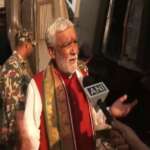
India News | BJP Accuses Nitish Kumar of Appeasement After Release of New Bihar School Calendar | LatestLY
Patna (Bihar) [India], November 28 (ANI): The Bharatiya Janata Party on Tuesday launched a fresh attack against the Nitish Kumar-led Bihar government for allegedly decreasing the number of holidays for the state’s schools during Hindu festivals and increasing it for Muslim festivals. Calling Nitish Kumar the “master of appeasement politics,” Choubey claimed that once again the anti-Hindu face of the JDU-RJD government has come to the fore, alleging that the Bihar government “hates Sanatan for vote bank.” Also Read | Telangana Assembly Elections 2023: Rahul Gandhi, Priyanka Gandhi Vadra to Campaign Jointly On Last Day Today. In a post on social media platform X, the veteran BJP leader said, “Once again, the anti-Hindu face of the uncle-nephew government came to…
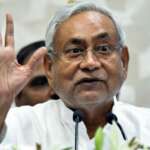
Bihar: BJP Accuses Nitish Kumar Of Appeasement After Release of New School Calendar, Says ‘He Hates Sanatan’
Patna, November 28: The Bharatiya Janata Party on Tuesday launched a fresh attack against the Nitish Kumar-led Bihar government for allegedly decreasing the number of holidays for the state’s schools during Hindu festivals and increasing it for Muslim festivals. ‘Master of appeasement politics’ Calling Nitish Kumar the “master of appeasement politics,” Choubey claimed that once again the anti-Hindu face of the JDU-RJD government has come to the fore, alleging that the Bihar government “hates Sanatan for vote bank.” In a post on social media platform X, the veteran BJP leader said, “Once again, the anti-Hindu face of the uncle-nephew government came to the fore. On one hand, holidays for Muslim festivals are being extended in schools, while holidays for Hindu…
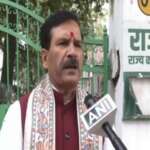
“BJP is poisoning education and trying to spread hatred…” : RJD leader Mrityunjay Tiwari over calendar row
Patna (Bihar) [India], November 28 (ANI): Rashtriya Janata Dal leader Mrityunjay Tiwari on Tuesday slammed the Bhartiya Janata Party for allegation of limiting the number of holidays for schools in Bihar during Hindu festivals and increasing it for Muslim festivals and said that BJP has become issueless, they are mixing poison in education and trying to spread hatred and enmity between peoples. “Politics on an important subject like education should not be done through the prism of religion and quality education and improvement in education is continuously happening under Nitish Tejashwi’s government. Nitish-Tejashwi’s government is determined to provide quality education, but the holiday table that has been released is for the year 2024. In that, those people from the BJP…

‘Mohammad Nitish And Mohammad Lalu:’ BJP’s Giriraj Singh Attacks Bihar Govt Over New School Calendar
Patna: The Bharatiya Janata Party on Tuesday launched a fresh attack against the Nitish Kumar-led Bihar government for allegedly decreasing the number of holidays for the state’s schools during Hindu festivals and increasing it for Muslim festivals. Calling Nitish Kumar the “master of appeasement politics,” Choubey claimed that once again the anti-Hindu face of the JDU-RJD government has come to the fore, alleging that the Bihar government “hates Sanatan for vote bank.” In a post on social media platform X, the veteran BJP leader said, “Once again, the anti-Hindu face of the uncle-nephew government came to the fore. On one hand, holidays for Muslim festivals are being extended in schools, while holidays for Hindu festivals are being abolished.” “Shame on…

MoS Nityanand Rai demands withdrawal of circular issued by Bihar govt related to holidays on religious festivals
New Delhi [India], November 28 (ANI): (ANI): Union Minister for State Home Affairs Nityanand Rai on Tuesday slammed the Bihar Government for reportedly decreasing the number of holidays for several Hindu festivals and demanded to withdraw the school calendar immediately issued by the Education Ministry of Bihar related to holidays for religious festivals. Bihar government’s holiday calendar for government schools in the state ahead of 2024 has sparked a political uproar. The BJP has slammed the Bihar government and questioned the school calendar alleging religious bias and hinting at appeasement of the Muslim community. Speaking to ANI, MoS Rai said, “The government of Bihar led by Nitish Kumar ji and Tejashwi Yadav is doing appeasement politics in Bihar. The festival…

India News | MoS Nityanand Rai Demands Withdrawal of Circular Issued by Bihar Govt Related to Holidays on Religious Festivals | LatestLY
New Delhi [India], November 28 (ANI): (ANI): Union Minister for State Home Affairs Nityanand Rai on Tuesday slammed the Bihar Government for reportedly decreasing the number of holidays for several Hindu festivals and demanded to withdraw the school calendar immediately issued by the Education Ministry of Bihar related to holidays for religious festivals. Bihar government’s holiday calendar for government schools in the state ahead of 2024 has sparked a political uproar. The BJP has slammed the Bihar government and questioned the school calendar alleging religious bias and hinting at appeasement of the Muslim community. Also Read | Chennai Shocker: Teenager Dies After ‘Injecting Himself With Drug’ at Friend’s Birthday Celebration in Hotel. Speaking to ANI, MoS Rai said, “The government…


